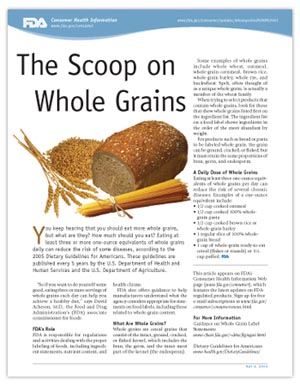The Scoop on Whole Grains
On this page:
You keep hearing that you should eat more whole grains, but what are they? How much should you eat? Eating at least three or more one-ounce equivalents of whole grains daily can reduce the risk of some diseases, according to the 2005 Dietary Guidelines for Americans. These guidelines are published every 5 years by the U.S. Department of Health and Human Services and the U.S. Department of Agriculture.
"So if you want to do yourself some good, eating three or more servings of whole grains each day can help you achieve a healthy diet," says David Acheson, M.D., the Food and Drug Administration's (FDA) associate commissioner for foods.
FDA's Role
FDA is responsible for regulations and activities dealing with the proper labeling of foods, including ingredient statements, nutrient content, and health claims.
FDA also offers guidance to help manufacturers understand what the agency considers appropriate for statements on food labels, including those related to whole-grain content.
What Are Whole Grains?
Whole grains are cereal grains that consist of the intact, ground, cracked, or flaked kernel, which includes the bran, the germ, and the inner most part of the kernel (the endosperm).
Some examples of whole grains include whole wheat, oatmeal, whole-grain cornmeal, brown rice, whole-grain barley, whole rye, and buckwheat. Spelt, often thought of as a unique whole grain, is actually a member of the wheat family.
When trying to select products that contain whole grains, look for those that show whole grains listed first on the ingredient list. The ingredient list on a food label shows ingredients in the order of the most abundant by weight.
For products such as bread or pasta to be labeled whole grain, the grain can be ground, cracked, or flaked, but it must retain the same proportions of bran, germ, and endosperm.
A Daily Dose of Whole Grains
Eating at least three one-ounce equivalents of whole grains per day can reduce the risk of several chronic diseases. Examples of a one-ounce equivalent include:
- 1/2 cup cooked oatmeal
- 1/2 cup cooked 100% whole-grain pasta
- 1/2 cup cooked brown rice or whole-grain barley
- 1 regular slice of 100% whole-grain bread
- 1 cup of whole-grain ready-to-eat cereal (flakes or rounds) or 1¼ cup puffed
This article appears on FDA's Consumer Update page, which features the latest on all FDA-regulated products.
Date Posted: May 6, 2009
Return to FDA Consumer Articles

